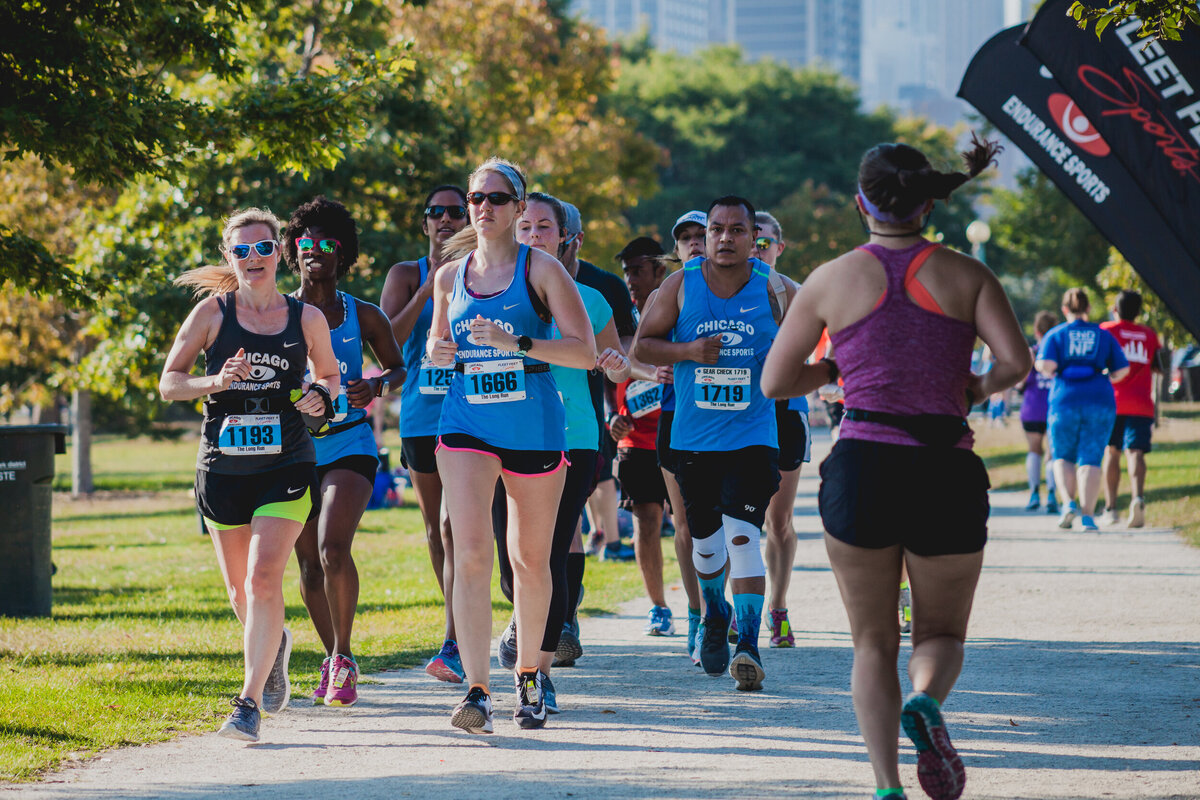Home>Misc>Featured>How Does Interval Training Differ From A Slow Jogging Program


Featured
How Does Interval Training Differ From A Slow Jogging Program
Modified: January 22, 2024
Discover the difference between interval training and a slow jogging program in this featured article. Enhance your fitness routine with targeted exercises and maximize your workout results.
Introduction
When it comes to cardio workouts, there are various options available, each with its own unique benefits. Two popular choices are interval training and slow jogging programs. These workout methods differ in terms of structure, intensity, and goals, providing individuals with different options to achieve their fitness objectives.
Interval training involves alternating between high-intensity exercises and short periods of rest or lower intensity exercises. It is a form of cardiovascular training that pushes the body to work at maximum capacity during short bursts. On the other hand, a slow jogging program focuses on steady-state cardio, where individuals maintain a slow and steady pace for an extended period of time.
In this article, we will dive into the key differences between interval training and a slow jogging program, shedding light on their varying structures, intensity levels, benefits, and goals. Whether you’re looking to improve your cardiovascular health, lose weight, or increase your endurance, understanding these differences will help you choose the right workout routine that aligns with your individual needs and preferences.
Definition of Interval Training
Interval training is a type of workout where individuals alternate between periods of high-intensity exercises and short periods of rest or lower intensity exercises. It is a form of cardiovascular training that has gained popularity due to its effectiveness in improving aerobic endurance, burning calories, and boosting overall fitness levels.
The structure of interval training typically involves performing exercises at a high intensity for a specific duration, followed by a short recovery period. This cycle is repeated multiple times during a single workout session. The duration and intensity of the high-intensity intervals can vary depending on the individual’s fitness level and goals. Examples of high-intensity exercises include sprints, burpees, mountain climbers, and kettlebell swings.
The key principle behind interval training is to push the body to its maximum capacity during the high-intensity intervals, which increases heart rate, promotes calorie burning, and improves cardiovascular endurance. The short recovery periods allow the body to partially recover before the next high-intensity interval, ensuring that individuals can maintain the desired intensity throughout the workout.
Interval training can be structured in numerous ways, such as the Tabata method, where individuals perform exercises at maximum effort for 20 seconds, followed by a 10-second rest, and repeated for a total of four minutes. Another popular approach is the HIIT (High-Intensity Interval Training) method, which involves alternating between intense exercises and periods of active recovery.
The flexibility and adaptability of interval training make it suitable for individuals of all fitness levels. Beginners can start with shorter interval durations and gradually increase intensity and duration as their fitness improves. Additionally, interval training can be customized to target specific muscle groups or incorporate a combination of cardiovascular and strength exercises.
Definition of Slow Jogging Program
A slow jogging program, as the name suggests, involves running or jogging at a slow and steady pace for an extended period of time. Unlike interval training, which focuses on high-intensity intervals, a slow jogging program relies on maintaining a consistent and moderate intensity throughout the entire workout.
The structure of a slow jogging program is relatively simple. Individuals typically start with a warm-up of brisk walking, gradually transitioning into a slow jog. The pace is set at a comfortable level where individuals can carry on a conversation without feeling overly strained. The duration of the workout can vary depending on fitness level and goals, but it is generally longer than interval training sessions.
The primary goal of a slow jogging program is to improve cardiovascular endurance and build a base level of aerobic fitness. By jogging at a steady pace, individuals can increase their heart rate and develop efficient oxygen delivery to the muscles. This sustained aerobic activity helps improve overall cardiovascular health, strengthen the heart, and enhance lung capacity.
Unlike interval training, a slow jogging program focuses less on calorie burning in a shorter amount of time and more on developing endurance and stamina. It is an ideal option for individuals looking to gradually build up their fitness levels, reduce the risk of injuries, and maintain a sustainable exercise routine.
Additionally, a slow jogging program allows individuals to enjoy the benefits of being outdoors and connect with nature. It provides an opportunity for stress reduction, mental relaxation, and the enjoyment of the surroundings. Many people find that slow jogging is not only a physical workout but also a form of mindfulness and escape from the daily stresses of life.
It is important to note that although the intensity of a slow jogging program is lower compared to interval training, it can still provide significant health benefits. It is a suitable option for beginners or individuals recovering from injuries who want to improve their fitness levels without putting excessive strain on their bodies.
Differences in Structure and Duration
Interval training and a slow jogging program differ significantly in terms of their structure and duration. These differences impact the intensity of the workout, the variation in exercises, and the overall time commitment required.
Interval training typically follows a structured format where individuals alternate between high-intensity exercises and short periods of rest or lower intensity exercises. The duration of each high-intensity interval can vary based on fitness level and goals, but typically ranges from 20 seconds to a few minutes. The recovery periods are also relatively short, allowing for a partial recovery before the next intense interval. The entire workout session can last anywhere from 10 minutes to 45 minutes, depending on individual preferences and fitness abilities.
On the other hand, a slow jogging program focuses on a consistent and moderate intensity throughout the entire workout. Individuals maintain a steady pace, typically at a slower jog, for an extended period of time. The duration of a slow jogging session is usually longer compared to interval training, ranging from 30 minutes to several hours. It is not uncommon for individuals to aim for runs lasting 45 minutes to an hour or more.
The structure of interval training allows for more variation in exercises and intensity levels. High-intensity intervals can involve a wide range of cardiovascular and strength-building exercises, such as sprints, burpees, plyometrics, and weightlifting. This variation helps target different muscle groups and provides a challenging and dynamic workout experience.
In contrast, a slow jogging program tends to have a more straightforward structure with a focus on consistent running or jogging. The exercises involved in a slow jogging program primarily revolve around maintaining a steady pace without significant variations in intensity or movement patterns.
Individuals who have limited time for workouts may prefer interval training due to its shorter duration. The high-intensity nature of interval training allows for a more efficient calorie burn and cardiovascular challenge in a shorter amount of time. On the other hand, individuals who have more time to dedicate to their workouts or enjoy the relaxation and mental benefits of sustained aerobic activity may find a slow jogging program to be a better fit.
When choosing between interval training and a slow jogging program, it is essential to consider personal goals, fitness abilities, and time availability. Both options have their merits, and finding the one that aligns with individual preferences and needs will result in a more enjoyable and effective workout routine.
Differences in Intensity and Effort
One of the significant differences between interval training and a slow jogging program lies in the intensity and effort required during the workouts. These differences impact the physiological responses of the body, the calorie burn, and the overall level of challenge experienced by individuals.
Interval training is known for its high-intensity nature. The workout sessions involve periods of maximum effort and high-intensity exercises, pushing the body to its limits. During the high-intensity intervals, individuals elevate their heart rate rapidly and engage multiple muscle groups simultaneously. The effort required is significant, often requiring individuals to exert themselves to the point of breathlessness and muscle fatigue.
On the other hand, a slow jogging program focuses on maintaining a steady and moderate intensity throughout the duration of the workout. The effort required is comparatively lower, as individuals aim to sustain a comfortable pace that allows for conversation without excessive strain. The heart rate is elevated, but not to the same extent as in interval training. The emphasis is on endurance and maintaining a consistent rhythm.
The varying intensities of these two workout methods result in different physiological responses within the body. Interval training triggers a phenomenon known as excess post-exercise oxygen consumption (EPOC) or the “afterburn effect.” This means that even after the workout session, the body continues to burn calories at a higher rate due to the increased metabolic demand from the intense intervals. Interval training has been shown to be highly effective for weight loss and improving overall cardiovascular fitness.
A slow jogging program, while less intense, still provides numerous health benefits. It helps improve aerobic endurance, increase lung capacity, and strengthen the heart. This steady-state cardio activity promotes fat burning and calorie expenditure during the workout, albeit at a lower rate compared to interval training. Slow jogging programs are particularly beneficial for individuals looking to build a base level of fitness, improve cardiovascular health, or recover from injuries.
When it comes to choosing between interval training and a slow jogging program, the desired level of intensity and effort is an essential factor to consider. If individuals thrive on pushing their limits and enjoy the challenge of high-intensity workouts, interval training may be the preferred choice. On the other hand, those who prefer a more moderate and sustainable effort level may find a slow jogging program to be the ideal fit.
It is worth noting that both workout methods can be adapted to individual fitness levels. Interval training can be personalized by adjusting the duration and intensity of the intervals to ensure it aligns with a person”s abilities and goals. Similarly, individuals engaging in a slow jogging program can gradually increase their pace or introduce intermittent intervals to add variation and increase intensity.
Differences in Benefits and Goals
Interval training and a slow jogging program offer distinct benefits and support different fitness goals. Understanding these differences can help individuals choose the workout method that aligns with their specific objectives and desired outcomes.
Interval training is known for its efficiency in burning calories and improving cardiovascular fitness. The high-intensity intervals increase the metabolic demand of the body, resulting in a significant calorie burn both during and after the workout. This makes interval training an effective option for weight loss and body composition improvement. Additionally, the intense bursts of exercise improve aerobic capacity, muscular endurance, and overall fitness levels.
On the other hand, a slow jogging program focuses on building endurance and maintaining a sustained aerobic activity. The steady-state cardio nature of this workout method improves cardiovascular health, strengthens the heart, and increases lung capacity. Slow jogging is often considered a form of meditation and stress relief, providing mental relaxation and a sense of well-being.
The goals associated with interval training typically include improving athletic performance, increasing power and speed, and achieving high levels of cardiovascular fitness. This method is popular among athletes, fitness enthusiasts, and individuals looking to challenge themselves and take their fitness to the next level. Interval training is also beneficial for those with limited time for workouts, as it provides a potent cardiovascular stimulus in a shorter amount of time.
A slow jogging program is ideal for individuals who prioritize endurance, sustainable fitness, and overall well-being. It is suitable for beginners, those recovering from injuries, or individuals looking for a low-impact option that can be incorporated into their daily routines. Slow jogging allows them to progress gradually, enjoy the mental benefits of being outdoors, and establish a consistent exercise habit.
Ultimately, the choice between interval training and a slow jogging program depends on individual goals, preferences, and physical abilities. Some individuals may prefer the challenge and intensity of interval training, while others may prioritize the endurance and mental relaxation that come with a slow jogging program. In some cases, combining both methods can provide a well-rounded fitness routine that includes elements of high-intensity intervals and moderate steady-state cardio.
It is important to note that both methods provide numerous health benefits, including improved cardiovascular health, increased calorie burn, and overall fitness improvement. By choosing the workout method that aligns with their goals, individuals can stay engaged, motivated, and make consistent progress towards achieving their desired outcomes.
Conclusion
Interval training and a slow jogging program offer distinct workout options, each with its own set of benefits and goals. Interval training involves alternating between high-intensity exercises and short periods of rest or lower intensity exercises, focusing on pushing the body to its limits. A slow jogging program, on the other hand, emphasizes maintaining a steady pace over an extended period of time, promoting endurance and mental relaxation.
The differences in structure and duration between these two methods provide individuals with options to choose a workout routine that suits their preferences and aligns with their specific goals. Interval training is renowned for its ability to burn calories, improve cardiovascular fitness, and increase athletic performance. It is an ideal choice for those looking to challenge themselves, save time, and achieve high-intensity workouts.
A slow jogging program, while less intense, offers benefits for individuals who prioritize endurance, sustainable fitness, and mental well-being. It helps improve cardiovascular health, build a base level of aerobic fitness, and provides a sense of relaxation when running outdoors. Slow jogging is particularly suitable for beginners, individuals recovering from injuries, or those seeking a low-impact option.
Choosing the right workout method depends on personal goals, time availability, and individual preferences. Some individuals may prefer the high-intensity intervals and variation of exercises in interval training, while others may find solace in the steady pace and mental benefits of a slow jogging program. Ultimately, incorporating elements from both methods can create a well-rounded fitness routine that combines the benefits of high-intensity intervals and sustained aerobic activity.
Regardless of the chosen method, it is important to listen to the body, start at a suitable fitness level, and gradually progress to prevent injury and promote long-term adherence. Fitness is a journey, and finding the right workout routine that brings enjoyment, challenges the body, and supports desired goals will lead to sustainable results and overall well-being.









